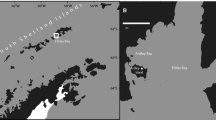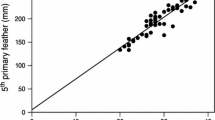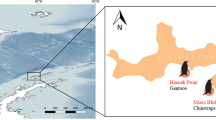Abstract
Feathers are used commonly for stable isotope analysis to assess the foraging ecology and migration patterns of birds. However, these studies often require knowledge of species-specific feather isotopic discrimination factors (the differences in isotopic ratios between a species’ diet and feathers), which can be influenced by a species’ physiological state during molt. In this study, we determined the isotopic discrimination factors (Δ13Cdiet−feather and Δ15Ndiet−feather) between adult gentoo penguin (Pygoscelis papua) diet and feathers in a controlled study. In addition, we tested whether molt duration or the magnitude of voluntary dietary reduction during molt influenced isotopic discrimination, as previous studies have found that nutritional stress can exaggerate 15N enrichment and in some cases lead to 13C depletion in feathers. Contrary to this hypothesis, we found no effect of molt duration or dietary reduction on discrimination factors, suggesting that isotopic discrimination is not linearly related to these measures of fasting intensity in penguins. Furthermore, we found that the range of Δ15Ndiet−feather found in several species of penguins, which fast while they molt, was similar to discrimination factors in fish-eating birds, which do not fast during molt. It is likely that species-specific metabolic adaptations that limit nutritional stress while fasting and variation in their relative reliance on endogenous vs. dietary pools during feather growth may confound the use of Δ15Ndiet−feather as a general measure of nutritional stress when comparing among species.

Similar content being viewed by others
References
Bearhop S, Waldron S, Voiter SC, Furness RW (2002) Factors that influence assimilation rates and fractionation of nitrogen and carbon stable isotopes in avian blood and feathers. Phys Biochem Zool 75:451–458. doi:10.1086/342800
Bond AL, Diamond AW (2010) Recent Bayesian stable isotope mixing models are highly sensitive to variation in discrimination factors. Ecol Appl (In press). doi: 10.1890/09-2409.1
Bridge EL (2006) Influences of morphology and behaviour on wing-molt strategies in seabirds. Mar Ornithol 34:7–19
Cherel Y (1995) Nutrient reserve storage, energetics, and food consumption during the prebreeding and premoulting foraging periods of King Penguins. Polar Biol 15:209–214. doi:10.1007/BF00239060
Cherel Y, Charrassin JB, Handrich Y (1993) Comparison of body reserve buildup in prefasting chicks and adults of King Penguins (Aptenodytes patagonicus). Physiol Zool 66:750–770
Cherel Y, Charrassin JB, Challet E (1994) Energy and protein requirements for molt in the King Penguin Aptenodytes patagonicus. Am J Physiol 266:1182–1188
Cherel Y, Hobson KA, Weimerskirch H (2000) Using stable-isotope analysis of feathers to distinguish moulting and breeding origins of seabirds. Oecologia 122:155–162. doi:10.1007/PL00008843
Cherel Y, Hobson KA, Bailleul F, Groscolas R (2005a) Nutrition, physiology, and stable isotopes: new information from fasting and molting penguins. Ecology 86(11):2881–2888. doi:10.1890/05-0562
Cherel Y, Hobson KA, Hassani S (2005b) Isotopic discrimination factors between food and blood and feathers of captive penguins: Implications for dietary studies in the wild. Physiol Biochem Zool 78(1):106–115. doi:10.1086/425202
Crissey S, Rice DF, Rice AL, McGill P, Slifka KS (2005) Diet and Nutrition. In: Penguin Husbandry Manual, 3rd edn. Penguin taxon advisory group of the American zoo and aquarium Association, pp 86–111 http://www.aviansag.org/standards.html
DeNiro MJ, Epstein S (1981) Influence of diet on the distribution of nitrogen isotopes in animals. Geochim Cosmochim Acta 45:341–351
Fox AD, Hobson KA, Kahlert J (2009) Isotopic evidence for endogenous protein contributions to greylag goose Anser anser flight feathers. J Avian Biol 40:108–112. doi:10.1111/j.1600-048X.2009.04720.x
Hintze J (2004) NCSS and PASS. Number cruncher statistical systems, Kaysville http://www.ncss.com
Hobson KA (1999) Tracing origins and migration of wildlife using stable isotopes: a review. Oecologia 120:314–326. doi:10.1007/s004420050865
Hobson KA, Clark RG (1992) Assessing avian diets using stable isotopes II. Factors influencing diet-tissue fractionation. Condor 94:189–197
Hobson KA, Alsaukas RT, Clark RG (1993) Stable nitrogen enrichment in avian tissues due to fasting and nutritional stress: implications for isotopic analysis of diet. Condor 95:388–394
Kempster B, Zanette L, LongstaVe FJ, MacDougall-Shackleton SA, Wingfield JC, Clinchy M (2007) Do stable isotopes reflect nutritional stress? Results from a laboratory experiment on song sparrows. Oecologia 151:365–371. doi:10.1007/s00442-006-0597-7
Klasing KC (1998) Comparative avian nutrition. CAB International, New York
Merilä J (1997) Fat reserves and moult-migration overlap in goldcrests, Regulus regulus–a trade-off ? Ann Zool Fenn 34:229–234
Miller AK, Karnovsky NJ, Trivelpiece WZ (2009) Flexible foraging strategies of gentoo penguins Pygoscelis papua over 5 years in the South Shetland Islands, Antarctica. Mar Biol 156(12):2527–2537. doi: 10.1007/s00227-009-1277-z
Minagawa M, Wada E (1984) Stepwise enrichment of 15N along food chains: further evidence and the relation between δ15N and animal age. Geochim Cosmochim Acta 48:1135–1140
Mizutani H, Fukuda M, Kabaya Y, Wada E (1992) δ13C and δ15N enrichment factors of feathers of 11 species of adult birds. Ecology 73(4):1391–1395. doi:10.2307/1940684
Murphy ME (1996) Energetics and nutrition of molt. In: Carey C (ed) Avian energetics and nutritional ecology. Chapman & Hall, New York, pp 158–198
Phillips RA, Catry P, Silk JRD, Bearhop S, McGill R, Afanasyev V, Strange IJ (2007) Movements, winter distribution and activity patterns of Falkland and brown skuas: insights from loggers and isotopes. Mar Ecol Prog Ser 345:281–291. doi:10.3354/meps06991
Polito MJ, Lynch HJ, Naveen R, Emslie SD (2011) Stable isotopes reveal regional heterogeneity in the pre-breeding distribution and diets of sympatrically breeding Pygoscelis penguins. Mar Ecol Prog Ser. In press. doi: 10.3354/meps08863
Ramos R, Militã T, González-Solís J, Ruiz X (2009) Moulting strategies of a long-distance migratory seabird: the Mediterranean Cory’s shearwater. Ibis 151:151–159. doi:10.1111/j.1474-919X.2008.00877.x
Rubenstein DR, Hobson KA (2004) From birds to butterflies: animal movement patterns and stable isotopes. Trends Ecol Evol 19:256–263. doi:10.1016/j.tree.2004.03.017
Sears J, Hatch SA, O’Brien DM (2009) Disentangling effects of growth and nutritional stress on seabird stable isotope ratios. Oecologia 159:41–48
Seminoff JA, Bjorndal KA, Bolten AB (2007) Stable carbon and nitrogen isotope discrimination and turnover in pond sliders Trachemys scripta: Insights for trophic study of freshwater turtles. Copeia 2007(3):534–542. doi:10.1643/0045-8511(2007)2007[534:SCANID]2.0.CO;2
Stonehouse B (1967) The general biology and thermal balance of penguins. Adv Ecol Res 4:131–196
Tierney M, Southwell C, Emmerson LM, Hindell MA (2008) Evaluating and using stable-isotope analysis to infer diet composition and foraging ecology of Adélie penguins Pygoscelis adeliae. Mar Ecol Prog Ser 355:297–307. doi:10.3354/meps07235
Vanderklift MA, Ponsard S (2003) Source of variation in consumer-diet δ15N enrichment: a meta-analysis. Oecologia 136:169–182. doi:10.1007/s00442-003-1270-z
Williams CT, Buck CL, Sears J, Kitaysky AS (2007) Effects of nutritional restriction on nitrogen and carbon stable isotopes in growing seabirds. Oecologia 153:11–18
Yuri T, Rohwer S (1997) Moult and migration in the northern rough-winged swallow. Auk 114:249–262
Acknowledgments
This research was funded by NSF OPP grants ANT-0125098 and ANT-0739575, with additional support from a Ralph W. Brauer Fellowship to M. Polito. We thank K. Vires, J. Beck, K. McGrath, T. Solberg and D. Rivard, and the staff of the Scott Kingdoms of the Seas Aquarium at Omaha’s Henry Doorly Zoo for their invaluable assistance with this study. T. Lankford and K. Durenberger provided assistance with lipid extractions and stable isotope analysis. We also thank Y. Cherel and K. Hobson for helpful insights during the preparation of this manuscript. This manuscript was improved through the comments of three reviewers: M. Beaulie, A. Bond, and C. Williams. This work complies with, and was completed in accordance to, IACUC permit number HDZ#07-800.
Author information
Authors and Affiliations
Corresponding author
Rights and permissions
About this article
Cite this article
Polito, M.J., Abel, S., Tobias, C.R. et al. Dietary isotopic discrimination in gentoo penguin (Pygoscelis papua) feathers. Polar Biol 34, 1057–1063 (2011). https://doi.org/10.1007/s00300-011-0966-5
Received:
Revised:
Accepted:
Published:
Issue Date:
DOI: https://doi.org/10.1007/s00300-011-0966-5




